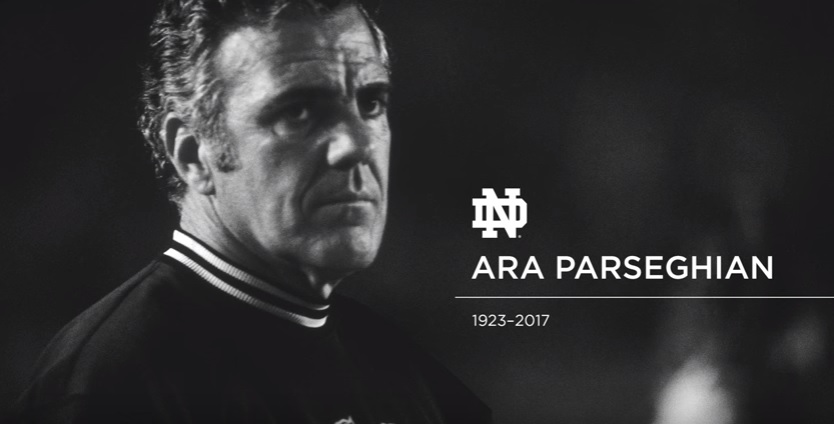I never met Ara Parseghian. Unless he sneaked past me on campus at some point I never even saw him in person. I was born in the reign of Faust, 8 years after Parseghian retired from coaching completely. Needless to say, Ara was before my time.
My dad visited campus when he was a boy and the only two things he could remember were that Ara was coach and they went to the pep rally in the field house. For Subway Alum’s such as ourselves these stories–when he didn’t even get to watch a game–were held in reverence.
It seems silly to even tell that story but Ara was such an enormous figure–just instant respect from everyone. And Notre Dame during that era, well it’s safe to say that powerhouse fit the bill. Merely stepping on campus then was like sensing and smelling true greatness.
A while back we had a short discussion in our comment section about the best 10-year era for college football. I vouched for something in the 1985 to 1995 period while most everyone else thought that any of the recent 10-year periods have been the golden age.
On his achievements alone you could make the case that Ara Parseghian is the best Notre Dame coach of all-time, and thus seriously in the conversation as the best coach in the history of college football. He was 95-17-4 over 11 seasons with the Irish with a pair of National Championships, plus damn good at Miami-Ohio, and plenty impressive at Northwestern. His accomplishments are deep and wide.
For me, Ara is quintessential Notre Dame and he coached in an era that in my opinion will always be quintessential Notre Dame. It may not have been the greatest 10-year period for the game of college football but it just might be an era that will never be topped in Fighting Irish annals. Here are some reasons why:
1) Father Ted Hesburgh was University President for over a decade before Ara was hired. Yet, Hesburgh’s peak as maybe the largest influential American Catholic leader came right during the Civil Rights Movement when Parseghian was coach. In many ways, both men are tied together as Mount Rushmore Notre Dame people.
2) Truthfully, Rockne and Leahy coached in an era overwhelmingly favoring Notre Dame, with a different set of rules on and off the field, and in a much different period in American history. Ara’s era was just modern enough for his accomplishments to actually mean something to kids today. You can flip on the tape of his games and it’s still a game similar to today’s, something that’s really hard to say for Leahy and Rockne.
3) Additionally, Ara was such a great “bridge” coach within the culture of America and Notre Dame. When he took over the game was broadcast sparingly in black and white TV. When he retired the game was being shown in color. When he started Notre Dame was an all-male school. By the time he retired the first couple years of women receiving undergrad degrees had already happened.
4) Of course, Parseghian coached and competed in an era of a heavy run-game on the field. All the same, he was a little more aggressive throwing the ball than many of his contemporaries. Most of his most famous offensive players (Huarte, Thiesmann, Snow, Casper, Hanrartty, Gatewood, Seymour, Clements) were either quarterbacks or pass catchers. This also provides a link to the more modern pass-heavy game. Perhaps the greatest single play in Notre Dame history came during Ara’s tenure, the audacious end zone pass from Clements to Weber in the ’73 Sugar Bowl.
5) Visually, the Parseghian era provided the archetypal “look” for all things Notre Dame. The plain unadorned gold helmets, the simple blue jerseys, the mustard pants, the knee-high pro-style socks. Millions of college football fans grew up in the era of color television watching this dominant Notre Dame program in a very standard and recognizable set of uniforms.
6) Ara was coach when Notre Dame finally entered the post-season bowl bonanza with some all-time classic wins against the likes of Texas and Alabama. He also faced USC arguably at their peak as a program and notched major wins (due to the era, of course) against so many blue-blood programs. When you look at the peak of the Lou Holtz era there are bowl wins against West Virginia, Colorado, Texas A&M, and Florida. Other major victories against the likes of Miami and Florida State, at the time not blue-bloods. Ara’s victories largely have a more historical feel to them and that can’t be discounted.
When you add all of this up and factor in the great human being that Ara was it’s kind of overwhelming. He may never get the publicity and hype to make him the best coach at his own program but that’s probably fitting for a man as humble as he was. He might be the best college coach of all-time and most of his own fans may not even know it.
RIP Ara.





I met him once. I think the place is called Pat’s Pub (not sure at all), somewhere in Mishawaka maybe, every inch was covered in Irish paraphernalia and they played the fight song regularly. My great great uncle or something was a cheerleader, class of 1940. He took me to this place when I was a freshman (his last ever trip to campus) and it was one of the coolest ND spots I have ever been. I guess it’s where the football old timers hung out because we sat at the table behind Lujack (who autographed my menu).
It was weird being one of the only “fans” in the place so full of ND legends. I think there were a couple other famous players and coaches there, but I wasn’t raised on ND, so those were the only names I remember (and honestly might not have remembered Lujack if I didn’t get his autograph). Everyone else was super old (at least to an 18 year old) and apparently just about everyone knew each other and had probably been going there for years.
Ara was super nice when we interrupted his table and he shook my hand. So cool. To this day, this was one of the coolest ND experiences I have ever had.
Outside of that one trip, I have never heard the place mentioned, never heard of anyone who has known about it, and never been back (never tried too hard as I don’t want to ruin what in my mind is an Eden). It’s one of those things that I question if it ever actually happened, and probably would assume it were a dream if not for the menu hanging up on my freshman year modular desk with Lujack’s signature.
Juicebox, I was at Pat’s Pub about 5 years ago and you described it to a tee. We went with my wife’s Aunt and uncle who live in SB and who were about as big of ND fans as you can imagine. I loved it but have not been back since. It’s still open. I’ll have to try to get back there again this fall. Here’s the address if anyone is interested (and doesn’t know how to use the Googles 😉). 12634 IN-23, Granger, IN 46530.
Very nice write up, Eric. I also never met Ara, but was very familiar with him while growing up (dad played for Leahy and ND football was huge to him). It’s odd, though. I remember going to a game in Devine’s first year and seeing buttons and stickers reading “Ara’s fine, but Dan’s Divine.” While Dan was an excellent coach, some people seemed glad that Ara was gone, or at least that’s the way it seemed to 11 year old me. A case of the New-Shiny-Object Syndrome, I guess.
Awesome. Sounds like your family fit right in at Pat’s.
As a fellow Domer who was born after Ara, you have taught me something and helped me grasp some of the impact of him. He was definitely never “my” coach, that was Lou, but I have a great appreciation for how great he was now.
Great job Eric.
Ara’s 1964 was – has to be – the single greatest turnaround season in college football history – maybe football period. To this day I can’t get my head around Huarte going from non letterwinner to Heisman, in the days when that was essentially impossible even for a blue blood.
The Ringer on Ara:
https://theringer.com/ara-parseghian-notre-dame-football-coach-dies-e442001c992f
ND did run the ball 4 times but, one was a roll out QB pass/run option play That never gets mentioned.
#1 goes into #2, loses their #1 RB pre game, their # 1 QB in the 1st qtr. Never the less, they rally from 10 pts. down and end up in a tie. Of course they stayed #1.
If Jimmy had kicked the extra point in 88′ , The U would have stayed #1. I’m not knockin Jimmy. In those circumstances, Ara would have gone for 2 also.
What a great man….R.I.P. Coach
Ara came to our house in ’64, looking to buy it. Dad had decided not to sell, but the real estate agent had not passed the word.. Like stated above, he was an incredible gentleman. I had seen him coach Northwestern and I think I was more impressed to meet him than dad, who had been buds with Leahy. I totally concur, 1964, my freshman year, was the single greatest turnaround season ever.
I do remember a couple of the players in our dorm commenting on how extremely tough Ara was in practice — “Ara is a bitch” was maybe one of the nicer comments. But that bitchiness was always overlaid on respect. I think that was my first introduction to what it takes to achieve excellence.
And yes, I was in East Lansing in ’66, and the Sugar Bowl in ’73. And yes, he made the right calls both games. In fact, he was a superb game day coach.
Thank you, Eric, for a very good piece.